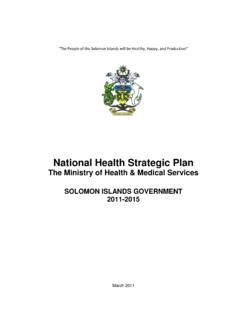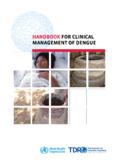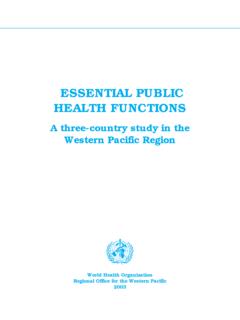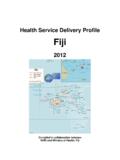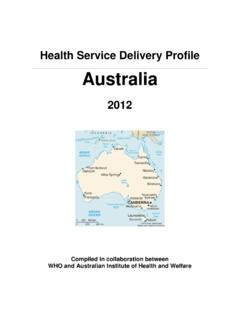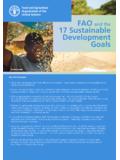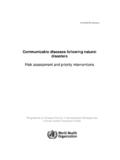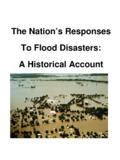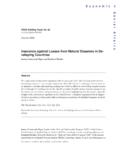Transcription of Safe Hospitals in Emergencies and Disasters - WPRO
1 safe Hospitals in Emergencies and DisastersStructural, Non-structural and Functional Indicators safe Hospitals in Emergencies and DisastersStructural, Non-structural and Functional IndicatorsAcknowledgmentsThis document is a project of the World Health Organization (WHO) Regional Office for the Western Pacific with support from the European Commission Humanitarian Aid department (ECHO) as part of the regional implementation of the global campaign on Hospitals safe from Disasters . The editorial staff is grateful for the efforts and initial work of Dr Carmencita Banatin and Dr Marilyn Go of DOH-HEMS on safe hospital indicators. We acknowledge the assistance of Dr Sheila Bonito for copy editing, and Mr Zando Escultura and Ms Aileen Baccay for the design and layout.
2 We thank Dr Lester Sam A Geroy, Ms Glessie Salajog and Mr Jan Robert Go for their valuable assistance in the production of this Library Cataloguing in Publication DataSafe Hospitals in Emergencies and Disasters : structural, non-structural and functional indicators. 1. Emergencies . 2. Emergency service, hospital . ISBN 978 92 9061 478 4 (NLM Classification: WX 185) World Health Organization 2010 All rights reserved. Publications of the World Health Organization can be obtained from WHO Press, World Health Organization, 20 Avenue Appia, 1211 Geneva 27, Switzerland (tel.: +41 22 791 3264; fax: +41 22 791 4857; e-mail: Requests for permission to reproduce or translate WHO publications whether for sale or for noncommercial distribution should be addressed to WHO Press, at the above address (fax: +41 22 791 4806; e-mail: For WHO Western Pacific Regional Publications, request for permission to reproduce should be addressed to the Publications Office, World Health Organization, Regional Office for the Western Pacific, Box 2932, 1000, Manila, Philippines, Fax.))
3 No. (632) 521-1036, email: designations employed and the presentation of the material in this publication do not imply the expression of any opinion whatsoever on the part of the World Health Organization concerning the legal status of any country, territory, city or area or of its authorities, or concerning the delimitation of its frontiers or boundaries. Dotted lines on maps represent approximate border lines for which there may not yet be full mention of specific companies or of certain manufacturers products does not imply that they are endorsed or recommended by the World Health Organization in preference to others of a similar nature that are not mentioned.
4 Errors and omissions excepted, the names of proprietary products are distinguished by initial capital reasonable precautions have been taken by the World Health Organization to verify the information contained in this publication. However, the published material is being distributed without warranty of any kind, either expressed or implied. The responsibility for the interpretation and use of the material lies with the reader. In no event shall the World Health Organization be liable for damages arising from its ..ivIntroduction ..1 World disaster Reduction Campaign on safe Hospitals ..1 safe Hospitals Vulnerability Assessment.
5 1 Target Users ..1 Objectives ..2 safe Hospitals indicators ..4 Structural ..5 Non-structural ..8 Functional ..23 Summary and conclusions ..38 References ..40 ContentsivSafe Hospitals in Emergencies and Disasters : Structural, Non-structural and Functional Indicators PrefaceHospitals are one of the essential institutions that must continue to function when an emergency event occurs . In spite of its importance, health facilities are themselves vulnerable to Disasters and can get damaged risking the lives of patients and health workers .This book presents structural, non-structural and functional elements that must be considered in order to ensure that the health facility can withstand and remain operational in Emergencies .
6 It forms an essential reference for hospital administrators and planners including architects, engineers, safety officers, management, and emergency managers . It enumerates indicators in the form of a checklist that can be easily used in planning for construction, retrofitting, renovation, and assessment of damages .These indicators were developed through years of experience, research, workshops, and reviews . Initial work was started by the Philippines Department of Health Health Emergency Management Staff (DOH-HEMS) and National Center for Health Facility Development (DOH-NCHFD) in partnership with the Association of hospital Administrators (AHA) Philippines through the support of the World Health Organization Regional Office for the Western Pacific (WHO-WPRO).
7 After further reviews by other experts and Member States including Cambodia, Lao People s Democratic Republic, and Viet Nam, this regional tool was developed .We hope that this tool will promote awareness of these essential elements and understanding that cost-effective strategies can be done to ensure safety . It is our goal that this book will assist government agencies and private stakeholders to start planning and incorporating these measures for preparedness in the health sector . Saving lives is our priority . Hospitals then must be safe from Disasters and prepared to do its vital role .This project was completed under the technical supervision of Dr Arturo M Pesigan of the Emergency and Humanitarian Action unit of WHO-WPRO.
8 1 IntroductionWorld disaster Reduction Campaign on safe HospitalsThe World Health Organization recognizes the need for making Hospitals safe , especially at a time of Disasters and Emergencies , when they must be ready to save lives and continue providing essential health services to the community . It supports the World disaster Reduction Campaign on safe Hospitals (2008-2009), which seeks to raise awareness and effect change that will: Protect the lives of patients and health workers by ensuring the structural resilience of health facilities . Ensure that health facilities and health services are able to function in the aftermath of Emergencies and Disasters , when they are most needed.
9 Improve the emergency management capacity of health workers and institutions . safe Hospitals Vulnerability Assessment Hospitals and health facilities play a critical role in times of emergency and Disasters . It is imperative that they remain structurally sound and fully operational at such times . To ensure that Hospitals and health facilities can withstand Emergencies and Disasters , an assessment of their vulnerabilities is most significant . These vulnerabilities may be structural (load-bearing system), non-structural (architectural elements, installation and equipment and (systems and operations) . This document, safe Hospitals in Emergencies and Disasters , began with the initial experience of the Philippines in formulating the sets of structural, non-structural and functional indicators for safe Hospitals .)
10 The Department of Health-Health Emergency Management Staff (DOH-HEMS) and the National Centre for Health Facility Development (DOH-NCHFD) of the Philippines, with support from the Association of hospital Administrators (AHA) Philippines and WHO S Western Pacific Regional Office, conducted several workshops . They included different technical working groups in health emergency management and experts in hospital structures and functional operations who proposed a list of indicators for safe Hospitals during Emergencies and Disasters . These indicators were reviewed to make them appropriate not only in the Philippines but also in Cambodia, the Lao People s Democratic Republic and Viet Nam.



